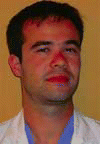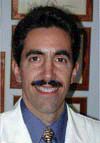ORLANDO, FL-Just how much of the nose plays a role in sleep-disordered breathing should probably get a bit more attention. A new study suggests that there may be such a thing as sleep-disordered nasal breathing, and that nasal congestion significantly worsens during the rapid eye movement (REM) stages of sleep.
Explore This Issue
August 2008Whether the nasal airway causes sleep-disordered breathing is somewhat controversial and not really perfectly characterized, but we do believe that in some or many patients, the nose does contribute to sleep-disordered breathing, said Luc G.T. Morris, MD, an otolaryngologist at the New York University School of Medicine, at an ARS session.
 Whether the nasal airway causes sleep-disordered breathing is somewhat controversial and not really perfectly characterized, but we do believe that in some or many patients that the nose does contribute to sleep-disordered breathing.
Whether the nasal airway causes sleep-disordered breathing is somewhat controversial and not really perfectly characterized, but we do believe that in some or many patients that the nose does contribute to sleep-disordered breathing.-Luc G.T. Morris, MD
Studies in the medical literature show that sleep stage is important to sleep-disordered breathing-most obstruction events occur during REM sleep. But the relationship between REM and what happens in the upper airway is not completely clear, he said.
It has been assumed that sleep-disordered breathing is partly due to REM muscle hypertonia, he said. The explanation is that during REM sleep, all the muscles in the body become partially paralyzed, and we sort of assumed that this would lead the pharyngeal airway dilator muscles to become weak and collapse.…The problem with that theory is that there is really no experimental evidence for it, Dr. Morris said.
He and his research team, which included two sleep specialists, wondered whether anything happened in the nasal airway during REM sleep that could contribute to sleep apnea events. To investigate this, a study was performed with 10 healthy, nonapneic volunteers. They underwent sleep studies at a university sleep lab and had overnight polysomnography, as well as acoustic rhinometry, while they slept.
Acoustic rhinometry was also performed before the subjects went to sleep and while they were in a sitting position. Another set of measurements was also attained while the subjects lay down for 15 minutes, but were still awake. After the subjects were asleep, two sets of measurements were done during two separate REM stages, as well as during two non-REM stages. In the morning after awakening, the subjects were decongested and morning baseline measurements were attained.
When patients were awake and seated prior to sleep, the mean congestion factor (MCF) of the nasal airway was 10.6%. In the supine position this increased to 16.2%. MCF was at its highest-22.3%-during REM. During non-REM sleep, MCF was at its lowest, at 2.3%. The differences were statistically significant.
That was full data from all 10 patients. But if we look at the 10 patients individually, one by one, nine of the 10 patients recapitulated the overall trend-which is that the nose was significantly more congested in REM sleep and less congested in non-REM sleep, he said.
The finding was different from what the researchers had anticipated. REM sleep is characterized by profound sympathetic activation throughout the body. And this goes along with profound vasoconstriction throughout the body, he said. One would expect a decrease in congestion, or shrinkage of the turbinates.
During REM sleep, there are three parts of the body that are preferentially perfused with blood: the kidneys, the mesenteric vasculature, and the brain. As a hypothesis of what is happening in the nose, we think that our results are best explained by increased carotid blood flow, and a concominant increase in blood flow to the ethmoidal arteries, which increases congestion in the nose during REM sleep as a side effect of increasing perfusion to the brain during REM sleep, Dr. Morris said.
This was a pilot study, however, and more research should be done to confirm the findings, and why increased congestion may be occurring, he said.
Pharmacologically Active Middle Meatal (MM) Stents
Also at the ARS session, attendees heard the latest about pharmacologically active middle meatal (MM) stents. Peter J. Catalano, MD, Chairman of the Department of Otolaryngology at the Lahey Clinic in Burlington, MA, described findings from a study investigating whether the stents provide benefit in patients undergoing endoscopic sinus surgery (ESS), and whether they are good carriers for local drug delivery.
This is the first study ever to evaluate middle meatal spaces for possible local drug delivery after endoscopic sinus surgery. We also introduced a new synthetic resorbable spacer that has been shown to be biologically inert, he said.
The study was designed to have three phases. Phase 1 was to evaluate the new synthetic middle meatal spacer, Nasopore®, and compare it to MeroGel. The latter has been shown to be biocompatible and biologically inert, Dr. Catalano said.
 This is the first study ever to evaluate middle meatal spaces for possible local drug delivery after endoscopic sinus surgery. We also introduced a new synthetic resorbable spacer that has been shown to be biologically inert.
This is the first study ever to evaluate middle meatal spaces for possible local drug delivery after endoscopic sinus surgery. We also introduced a new synthetic resorbable spacer that has been shown to be biologically inert.-Peter J. Catalano, MD
Phases 2 and 3 evaluated Nasopore, a bioresorbable, compressive foam, as a drug delivery technology in patients undergoing ESS. It comes in several different shapes. And you could cut it to any shape you want, he said.
A total of 35 patients with chronic rhinosinusitis (CRS) who were undergoing sinus surgery were included in the phase 1 part of the study. Each patient had a MeroGel stent placed in the middle meatus on the right, and a Nasopore square in the middle meatus on the left. Each patient also received one week of postoperative oral antibiotics, a Depo-Medrol injection in recovery, and nasal irrigations for a month at follow-up visits.
There were 69 patients in the phase 2 portion of the study. Here, plain Nasopore was used in the left middle meatus, and for the right side, the foam was soaked in a Bacitracin solution of 50 mg/cc. Patients underwent the same postoperative regimen but had two fewer days of oral antibiotics. Endoscopy was performed postsurgery to evaluate the middle meatus at two, six, and 12 weeks.
At the end of phase 1, researchers found no real differences between the two groups of patients. Nasal congestion in almost every patient was normal up to two weeks. Headaches were again pretty equal and normal postoperatively. The infection was higher in the MeroGel side than the Nasopore side, but nothing that was of significance, Dr. Catalano said. The stents had all dissolved by a 14-day postsurgery follow-up visit.
As for results from phase 2, there were only minor differences found between patients who received the pharmacologically active stents and those who received the plain ones. On the Bacitracin side versus the plain side, there was absolutely no evidence of any kind of biological reactivity, he said.
Phase 3 is under way and will prospectively evaluate Nasopore for local drug delivery in a randomized controlled trial without systemic antibiotic coverage. The overall goal is to minimize or eliminate the need for systemic medications and their associated side effects and costs, he said.
However, Dr. Catalano noted there were some limitations to the study and that more research needs to be done. This was essentially a feasibility study.
This study is limited by its sample size and the lack of a control group. For the study to be powered properly to show a statistical significance, we’d have to have about 700 patients, due to the relatively low incidence of postoperative sinusitis in this population. It does, however, represent an important first step in attempting to provide local drug delivery for patients undergoing endoscopic sinus surgery, he said.
©2008 The Triological Society
Leave a Reply